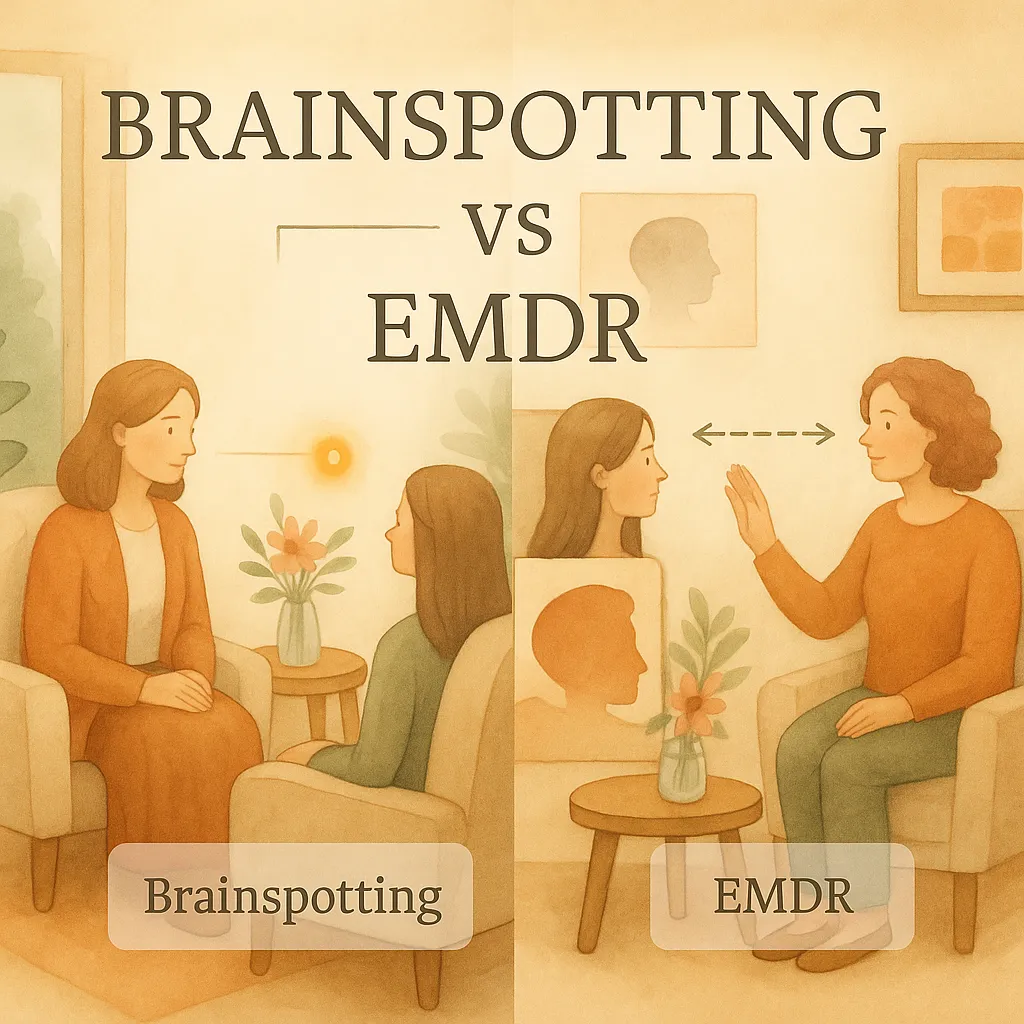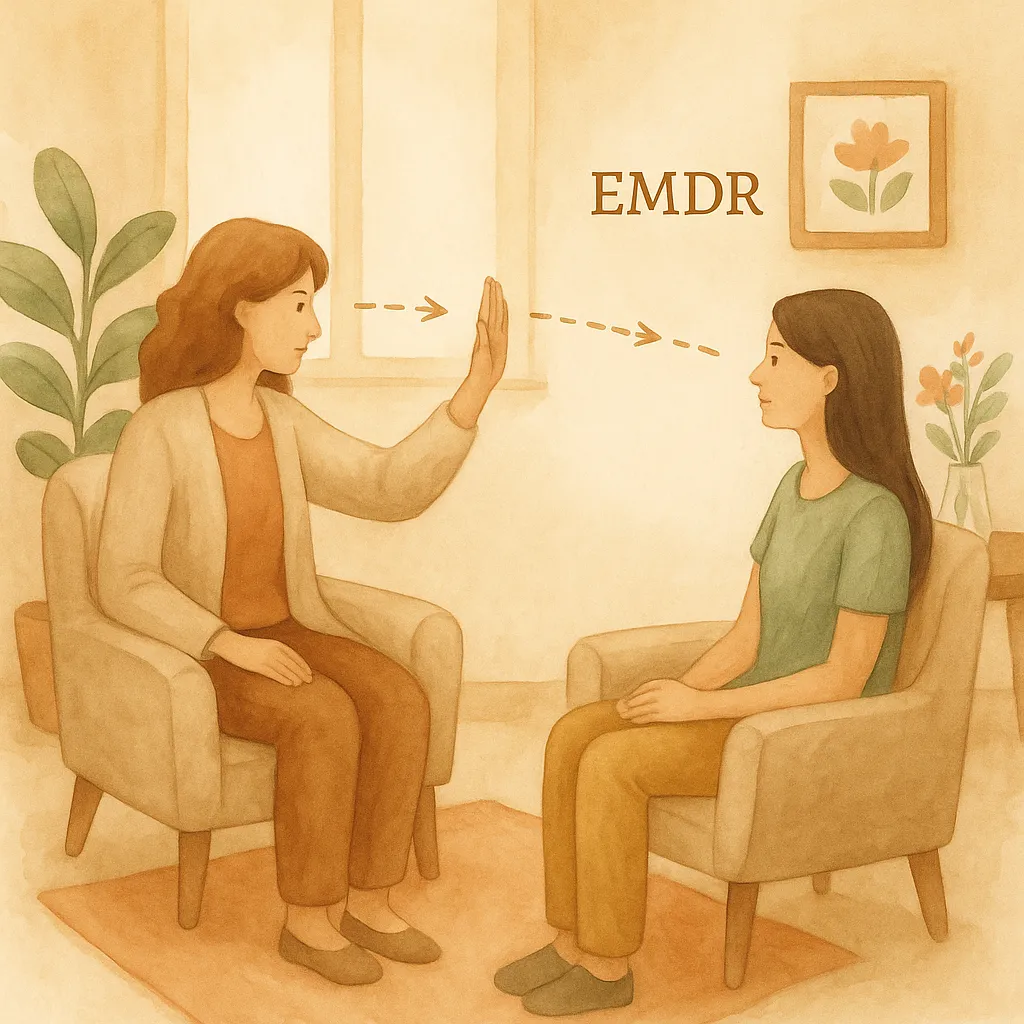Brainspotting vs. EMDR: Which Somatic Therapy Is Right for You?
You’ve probably heard of EMDR. You may have also come across Brainspotting. Both are powerful, body-based therapies for healing trauma, anxiety, and the lingering effects of overwhelming experiences. But if you’re standing at the crossroads, wondering which path is right for you, it can feel a little overwhelming. You want something that works. That honors what you’ve been through. Something that actually helps you feel different, and calmer in your body, clearer in your mind, and more at ease in your life.
As a somatic therapist in Phoenix who specializes in Brainspotting, I’ve worked with many people. Often, they came in asking the same question. What’s the difference between Brainspotting and EMDR? Also, how do I know which one is right for me? This blog will walk you through both approaches. It will highlight where they overlap. And show where they differ. Helping you start to get a feel for which might fit best for you.

What Is Somatic Therapy and Why Does It Matter?
When we talk about somatic therapy, we’re talking about therapy that includes the body in the healing process. It's not just about your thoughts or your story. This matters because trauma, stress, and emotional overwhelm aren’t just “in your head.” These experiences live in the nervous system. They may appear as muscle tension that won’t go away, trouble sleeping, chronic fatigue, or difficulty concentrating. You may even feel emotionally numb.
Somatic therapy helps you reconnect with your body in a safe, intentional way so you can release what’s been held there. This isn’t just about mindfulness or breathwork (though those can be part of it). It’s about listening to your body’s cues, processing stored experiences, and teaching your nervous system how to feel safe again. There are many forms of somatic therapy in Phoenix: Brainspotting, EMDR, Polyvagal Therapy, movement-based work, and more. Both Brainspotting and EMDR work within this category, but they approach the process in different ways.

How Does Brainspotting Work?
At its core, Brainspotting is about finding and focusing on specific eye positions, called “brainspots”, that link to where your brain and body have stored an experience. By gently holding your gaze on that spot, your brain gets direct access to the deeper, subcortical areas where trauma and stress responses live. This is the part of the brain that governs survival — fight, flight, freeze — rather than logic and language. The process is collaborative. I’ll guide you to notice sensations, images, thoughts, or emotions that arise, and we’ll track how your body responds. You don’t have to rehash the whole story.
There’s also no need to push through details you’re not ready to revisit. We follow your body’s lead. And in doing so, your nervous system has the opportunity to process and release what it’s been holding — gently, safely, and at your own pace. Many people find brainspotting treatment especially helpful when they’ve tried talk therapy and still feel stuck, when they’re living with medical trauma, anxiety, or chronic pain, or when they sense something unresolved but can’t quite name it.
Could Brainspotting Be the Right Fit for You?
Are you wondering if Brainspotting might be the kind of support your mind and body have been looking for? Perhaps you’re curious about how it works in real life, or whether it could help with the specific challenges you’re facing. This next section will walk you through common situations where Brainspotting can be especially helpful. As you read, notice if any of these experiences feel familiar to you.
You may be looking for a body-based approach but prefer not to be pushed into talking about every detail. Perhaps you’ve felt “stuck” even after previous therapy or other healing work. Anxiety, medical trauma, grief, chronic pain, or performance blocks might be making daily life more difficult. A flexible, client-led approach that lets you set the pace could feel safer and more sustainable. Or maybe you’re supporting a child or teen who needs a gentler, developmentally appropriate therapy experience.

What Is EMDR?
EMDR, which stands for Eye Movement Desensitization and Reprocessing, is another well‑researched trauma therapy. It also uses the brain‑body connection to process distressing memories. In EMDR, you identify a specific memory or event, and while focusing on it, you engage in bilateral stimulation, often guided side-to-side eye movements, taps, or tones.
This bilateral stimulation helps the brain reprocess the memory so it’s less triggering. Instead of feeling like it’s happening “right now,” the brain can move it into the past where it belongs. EMDR typically follows an eight-phase structured protocol that includes preparation, assessment, processing, and integration.
When EMDR Might Be the Right Fit
You might wonder when EMDR could be the right fit for your healing journey. In my experience, people are often ready for EMDR when they feel safe enough to revisit certain memories and trust they have the support to process them. A clear, structured, step-by-step process can feel reassuring if you like to know what’s coming next in each session. You may have specific events you want to work through and feel drawn to a method with a strong foundation in research and proven results for PTSD and trauma recovery.
What Are the Similarities Between Brainspotting and EMDR?
Both Brainspotting and EMDR are somatic therapies that honor the connection between the brain and the body in healing. Each works directly with the nervous system to address trauma, anxiety, and other challenges stored in both mind and body. They use tools such as eye position or bilateral stimulation to activate the brain’s natural ability to process and integrate difficult experiences. Over time, this can ease distress, lessen intrusive thoughts, and reduce emotional reactivity. Both approaches can also be blended with other therapeutic methods to create a more comprehensive and supportive healing experience.

Key Differences Between Brainspotting and EMDR
Before we dive into the specifics, it’s helpful to understand how these two approaches stand apart. While both are rooted in the brain‑body connection and offer powerful ways to process unresolved experiences, they go about it in different ways. The differences often come down to structure, the level of detail you share, how the processing unfolds, and the pace that feels right for you. Knowing these distinctions can make it easier to sense which path might fit your needs and comfort level best.
Structure vs. Flexibility:
EMDR tends to follow a clearly defined protocol from start to finish, which can provide a sense of predictability and step‑by‑step guidance. Brainspotting offers a more open‑ended, client‑led process that shifts in the moment to meet you exactly where you are, allowing the session to follow your body’s cues rather than a strict roadmap.
Level of Detail:
EMDR often involves revisiting and describing the memory in detail so it can be fully reprocessed. Brainspotting allows you to work without sharing or even consciously recalling all of the specifics, which can feel safer if the memory is unclear, overwhelming, or too raw to put into words.
Processing Style:
EMDR maintains focus on a chosen memory while using bilateral stimulation to support reprocessing. Brainspotting follows the natural flow of your body and brain, letting the process unfold based on what feels safe and relevant in the moment—whether that leads to a specific memory, a physical sensation, or an emotional release.
Pacing:
Brainspotting adapts moment‑to‑moment to your nervous system’s readiness, allowing you to slow down or pause as needed. EMDR generally moves through a series of pre‑set phases, which can be grounding for some clients but may feel too fast‑paced for others depending on their level of readiness.
How to Decide Which Is Right for You: Brainspotting or EMDR
Choosing between Brainspotting and EMDR isn’t about one being “better” than the other, it’s about finding the right fit for where you are in your healing journey. It often comes down to your personal preferences and your readiness to explore certain memories. It’s also shaped by the kind of process that feels most supportive to you. Some questions to consider:
Do I want a more flexible or more structured approach?
Am I ready to revisit specific events, or do I need something that works without doing that?
Do I feel safer letting my body guide the process, or do I want a set map to follow?
How much do I want to talk during the session versus work more internally?
Sometimes, clients start with one method and move to the other later. Others use both at different points in their healing journey. You might move from EMDR to Brainspotting if you find you need a gentler, more body-led approach after doing structured memory work. Or you could begin with Brainspotting and transition to EMDR once you feel ready to revisit specific memories in more detail.

What Brianspotting Looks Like in My Practice
In my work at Through It All Counseling, I primarily use Brainspotting because it offers flexibility, depth, and a client-led pace that supports nervous system safety. I integrate it with other approaches — Play Therapy, Expressive Arts, Polyvagal-informed work — so each session is tailored to the person in front of me.
For children and teens, that might mean combining Brainspotting with creative or movement-based activities. For adults, it might include mindfulness, guided imagery, or breathwork. I value EMDR and respect its impact. In fact, if a client comes to me and I sense EMDR might be a better fit for their current needs, I’m happy to help them connect with an EMDR-trained colleague.
Your Healing, Your Choice
Whether you choose Brainspotting, EMDR, or another form of somatic therapy in Phoenix, the most important thing is that it feels safe and right for you. Healing isn’t about forcing your way forward. It’s about finding the support that meets you where you are, works with your nervous system rather than against it, and allows you to move toward relief and resilience at your own pace.
Could Brainspotting in Phoenix Be the Somatic Therapy Approach That Aligns Best With You?
If you’ve been reading this and thinking about how Brainspotting and EMDR might fit into your own healing, it may be the right moment to pause and check in with what your body is telling you. At Through It All Counseling, Brainspotting in Phoenix offers a deeply compassionate, body‑based approach that aligns with the very principles we’ve explored in this blog. Just as we’ve discussed, Brainspotting doesn’t require you to push harder, relive every detail, or fit into a rigid structure—it allows your nervous system to guide the process at a pace that feels safe.
Whether you’re working through trauma, medical challenges, anxiety, or a heaviness you can’t yet name, my role is to walk beside you, helping you reconnect with your body’s wisdom and your own capacity for resilience. You don’t have to carry this alone. Healing is about creating safety, regaining your sense of self, and remembering you are allowed to feel better. When you’re ready to take the next step, I’m here to help you begin.
Take the first step today.
Then reach out to schedule your Brainspotting session and begin your journey toward freedom, clarity, and wholeness.
Other Therapy Services Offered at Through It All Counseling in Scottsdale and Phoenix, Arizona
Somatic therapy isn’t just one method—it’s an approach that honors your body as an essential partner in healing. In my work, this means offering a range of integrative, creative, and evidence‑informed therapies that support the whole person: mind, body, and nervous system. Whether you’re a parent helping a child navigate big feelings, working through the shifts of a major family transition, or carrying your own experiences of trauma, illness, or anxiety, you deserve support that meets you exactly where you are.
Alongside Brainspotting, I offer Play Therapy, Expressive Arts, Bibliotherapy, and Creative Art Therapy to help children and expressive learners process emotions through movement, metaphor, and imagination. For adults and families, I incorporate Polyvagal Therapy, Mindfulness‑Based Interventions, Parent Work, Family Systems Therapy, and Co‑Parenting Support—each grounded in safety, curiosity, and compassion. When more structure is helpful, I may weave in Cognitive Behavioral Therapy (CBT), Solution‑Focused Brief Therapy (SFBT), or Motivational Interviewing.
Healing might look like sitting quietly in a moment of calm. It might look like painting, moving, breathing, or gently rewriting the stories your body has carried for far too long. No matter where you are in your journey, my role is to help you discover the approaches that feel most supportive and meaningful for you.
About the Author
Cristina Yturralde, M.C., LPC, is a certified Brainspotting therapist, Brainspotting Consultant, and somatic therapist in Phoenix. She brings nearly 20 years of clinical experience and over 30 years of dedicated work supporting families navigating chronic illness, grief, and emotional overwhelm. Cristina’s approach is rooted in both personal and professional experience. After discovering the mind-body connection through her own healing journey, she became passionate about somatic therapy as a path to lasting change.
Since 2020, Brainspotting has transformed her work and her clients’ lives by offering a gentle, body-based method for addressing trauma, pain, anxiety, and medical stress without having to rehash every detail. In her private practice, Through It All Counseling, Cristina supports children, teens, and adults using a deeply integrative approach. She blends Brainspotting with Play Therapy, Expressive Arts, Polyvagal-informed care, and other nervous-system-focused techniques. Whether you’re a parent watching your child struggle or an adult looking to feel more grounded and whole, Cristina offers a warm, steady presence to help you soften into healing, one step at a time.







